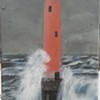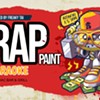"Well how-dee-do, y'all. Welcome to the wide world of cartoon caricature. C'mon in 'n' meet ever one."
Say hello to Daisy Mae of Dogpatch.
Daisy Mae greets us inside the gallery door at the Levine Museum of the New South. Innocent, statuesque and bodacious, Daisy Mae is L'il Abner's gift from God. He doesn't deserve her. She visited me many mornings of my childhood, courtesy of Al Capp, cartoonist extraordinaire. Daisy Mae and Capt'n Crunch for breakfast. A fine sunrise howdy-do.
The Levine Museum of the New South presents a cartoon view of the Old South with Comic Stripped: A Revealing Look at Southern Stereotypes in Cartoons. Readers over 30 can visit and re-visit old friends, and younger readers will meet the skewed characters that mid-century cartoonists plucked from the southern landscape -- The Mountain Boys, Snuffy Smith, L'il Abner, Pogo and Kudzu.
"Balls O' Fire!!!"
The Mountain Boys was drawn by a Pennsylvania Yankee named Paul Webb, who never set foot in our South until he started making fun of it. Mr. Webb ran his cartoons in Esquire magazine from 1934 through 1958.
The Mountain Boys were long-bearded, skinny, pipe-smoking, sloped-shouldered and head-scratching hill folk. Webb pulled his mountain folk from radio, magazines, books and TV, wherever he could find stories. He ventured south later to check his comic speculations. Luke and Willy and Jake and Ma and Pa are fine introductions into Southern life through a distant Northern lens.
This clan is mostly ignorant and lazy, often mean-spirited and occasionally droopy drunk on the juice.
"Yonder comes the parson, Maw."
The comic strip Snuffy Smith was first penned by Chicago native Billy DeBeck, Yankee. Snuffy stands 4'10", over-alled, sock-footed, unshaven, and is seldom seen without his whiskey jug nearby. He sleeps a lot, and when he wakes, he yells, usually at his wife Loweezy. Loweezy wears a rimless polka dot bonnet, apron, army boots, and weighs in at Snuffy times three. Like all the women in the South, she appears to do the hog's share of the work around the cabin -- cookin', cleanin', choppin' wood.
Well, all the work.
"Dawgone! Ah caint read this letter on account ah caint read anyhow!!"
Al Capp was from Bridgeport, Conn. (another Yankee). Capp penned L'il Abner from 1937 to 1977. His comic strip was the most popular of them all, which is partially accountable to the fact he drew the best pictures. The Dogpatch landscape is ramshackle shanties, wobbly fences, front yards with washtubs and busted trucks, and long toothed varmints, both four-legged and standing upright. Or as L'il Abner tells it: "That's the miracle o' Dogpatch!!! Thet enormous boulder been wobblin' dangerously over our l'il town fo' thousands 'o y'ars -- an it h'aint fell yet!!!"
He's very excitable.
Dogpatch is home to L'il Abner, the voluptuous Daisy Mae, Mammy and Pappy Yokum, all their kinfolk, and their neighbors, tame and treacherous, all tetched in the haid. As Al Capp tells it, there was "no simpler Hillbillies in all them hills than Mammy and Pappy."
"We have met the enemy, and he is us."
Walt Kelly was another Connecticut Yankee. He wrote the comic strip Pogo, which ran daily for 26 years, up to 1977.
Pogo is a thoughtful possum -- a favorite Southern critter. Pogo lives in the Okefenokee Swamp in Georgia and his cartoon swamp buddies are a different cut from the L'il Abner and Snuffy Smith mold. They are animal -- and smarter than humans: philosophical, clever and introspective, and prone to political and social commentary. The denizens of this swampland resemble a cross between Mark Twain and Wile E. Coyote, while the Yokum and Smith clans seem likely spawned from the union of a laughing jackal and a snake-handling professional wrestler.
In 1953, Kelly got some heat with the appearance of his character Simple J. McCarthy, a spoof of Senator Joseph McCarthy, the fearsome blowhard senator tracking phantom Commies with his Un-American Activities Committee. Kelly later lampooned Nixon and his minions, including FBI director J. Edgar Hoover. The Director of the FBI suspected coded messages might be included in the Southernisms and nonsense poetry printed in the Pogo strip. Attempts at deciphering the crypts proved fruitless.
One of Kelly's last strips was for Earth Day, 1971. Pogo and his buddy Porkypine traipse through the "Forest Primeval." When they come to a clearing in the forest littered with human detritus -- a swampy fill of garbage -- Pogo and Porky Pine sit and scowl at the waste.
"Yep, son," says Pogo, "we have met the enemy, and he is us."
Pogo makes his 15th run for President of the United States this year. Register now.
"I been rode hard 'n' hung up wet!!!"
Then there's Kudzu, by Doug Marlette.
The characters of Kudzu live in Bypass, N.C. The main players are the bombastic Preacher Will B. Dunn, Uncle Dub, one of the last surviving good ol' boys, and Kudzu Dubose, an aspiring writer, who poses all the questions about what it means to be Southern in the postmodern South.
Marlette was the only Southern-born newspaper cartoonist represented here. He's not a Yankee looking south and looking down; he's looking left and right to his neighbors -- to those he lived with and knew growing up. Kudzu Dubose is reflective and thoughtful and he wrestles with Southern character, the good and the bad, and characterizations of his homeboys ranging from bull's-eyes to bullshit. He worries about homogenized America smothering his South like tasteless gravy poured over fine biscuits. He worries the Good Ol' Boy will vanish, but not before he is commoditized.
Marlette wrestles with losing his unique landscape, and fights those forces of unwanted change, while he gently skewers his Southern brothers and sisters. Kudzu is the best of the Southern comic strips.
Curator Tom Hanchett touches on, and illustrates, subjects and issues explored in comic strips depicting folks from the South. He includes topics cartoonists explored for the amusement and interest of the readers, including fighting and feuding, Southern beauties, loose sexuality and race. Placards throughout the show quote reflections about Southern culture. My favorite:
"The South is like an old pair of jeans -- shrunk a bit, faded some, a few holes ... But it's more comfortable than it used to be, and there's still a lot of wear in it." -- sociologist John Shelton Reed, 2007.
Comic strips depicting Southern characters paraded across newspaper pages read by 50 million folks in America every day. That's some powerful advertising. I don't figure all these folks reading L'il Abner and Snuffy Smith and Pogo shuffled out their front doors thinking we were really shiftless and slow and clueless and loose and lazy. If they did, they wouldn't visit so often. Folks from places like Detroit and Pittsburgh and Buffalo have been marching south in numbers that would make Sherman's Army look like a Peach Blossom Parade, and they've been doing it for 50 years. And unlike Sherman's boys, these folks stayed.
But being gracious and forgiving and forgetful like Daisy Mae, we welcome them in. We set out the sweet tea and mason jars and listen to the words they say and the way they talk. And when they step off the porch and drive out to their quarter-acre spread out past 485, we sit on the porch and talk about them.
Someone aughta make a comic strip.
The run of Comic Stripped: A Revealing Look at Southern Stereotypes in Cartoons has been extended through May 30, 2008. For information, call 704-333-1887 or go to www.museumofthenewsouth.org.
Latest in Feature
More by Scott Lucas
Calendar
-
An Evening With Phil Rosenthal Of "Somebody Feed Phil" @ Knight Theater
-
Kountry Wayne: The King Of Hearts Tour @ Ovens Auditorium
-

NEW WINDOW GALLERY-Pat Rhea-ACRYLIC PAINTINGS-April 05-30 2024 VALDESE, NC 28690 @ New Window Gallery/Play It Again Records
- Through April 30, 12 p.m.
-

Trap & Paint + Karaoke @ Zodiac Bar & Grill
-

LIVE MUSIC FRIDAYS!!! @ Elizabeth Parlour Room
-
Holiday Gift Guide
26 ways to shop local this holiday season
-
Fall Guide: Upcoming festivals, comedy shows, visual arts events and more
-
Halo 4 earns critical hallelujahs
Plus, news on Mass Effect Trilogy, LEGO: The Lord of the Rings














